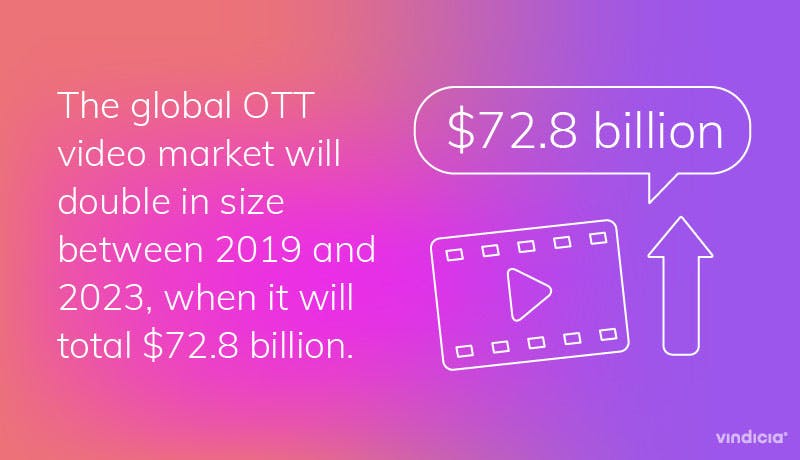Blog
September 17, 2020 | Authored by: Jesus Luzardo
What does the future hold for OTT video subscriptions?
Consumer demand for over-the-top (OTT) video is on the rise, thanks in no small part to the recent COVID-19 crisis. For the past several months, millions of people have been largely confined to their homes, hungry for new content to entertain them and help pass the time.
Meanwhile, communications service providers (CSPs) are just as eager to partner with OTT providers and increase their delivery of video streaming services to defend their existing pay-TV offers from churn, or grow in new content domains without the demand for heavy investment.
According to PwC, the global OTT video market will double in size between 2019 and 2023, when it will total $72.8 billion. A rapidly expanding marketplace means increased competition for OTT video service providers, who must find the right go-to-market (GTM) strategy to distribute their services, reach more customers, grow their install base, and drive more recurring revenue.
There are many different players in the marketplace, from dedicated subscription services like Netflix to traditional telecom carriers like AT&T’s HBO Max, each with its own internal mandate and measure of success. In addition, numerous OTT video service providers continue to jostle for market position, growing their brand and reaching as many new audience members as possible.
Those players have just as many different types of GTM partnership strategies to consider, and with the right combination of strategic partnerships and GTM strategies, OTT video services can maximize profits and expand their audience in the face of rising market competition. Looking toward the future of OTT video subscriptions, what types of GTM partnerships and service bundles are available, and what can they offer OTT video streaming companies?

Subscription bundles present a win-win scenario
OTT video providers can also partner with other brands to bundle their services with other products at a discounted rate, or sometimes completely free for a period of time.
As one of the leading innovators in subscription bundles, it’s no surprise that Apple has also branched out into this arena. The company recently launched a promotion offering AppleTV+ users discounted rates on CBS All Access and Showtime subscriptions when bundled together. Customers can save 50% bundling all three services rather than paying for each individually.
OTT video streaming service providers don’t necessarily need to look externally to form such mutually beneficial partnerships. They may also work with product teams within their own companies to build bundles that broaden both sides’ user base. Consider how Apple leverages the install base for its popular mobile device product lines to expand its OTT video audience. The company currently offers a free year’s subscription to AppleTV+ to customers who buy an iPhone, iPad, or Mac, among other Apple products. And just this week Apple announced its latest bundle, Apple One, with all tiers of service including AppleTV+.
This approach helps OTT video providers reach a wider audience of potential customers who would enjoy and benefit from their services. Both OTTs and subscription partners benefit from the increased value of their offerings and the opportunity to drive higher attachment to devices and video services.
CSP service bundles promise comprehensive OTT solutions
Partnering with a communications service provider opens up new opportunities for OTT video services to reach a wider audience and build out their customer base. There’s no denying the appeal of an all-in-one OTT solution: 70% of U.S. consumers would pay for a single provider to deliver all of their content needs.
There are multiple examples of leading CSPs and OTT video companies exploring these types of partnerships. Canada-based TELUS, for instance, reached an agreement with Amazon earlier this year to include Amazon Prime subscriptions as part of its Optik TV package.
For these partnerships to succeed, both sides will need to address some pretty significant logistical challenges, including integration concerns. However, it’s worth the effort to overcome those obstacles and deliver a seamless user experience across the entire platform.
PayTV partnerships take on cord-cutting
Cord-cutting is an ongoing concern for traditional cable providers, with the five largest payTV companies losing 1.6 million customers in the first quarter of 2020 alone. With no end in sight to this trend, cable providers are on the lookout for opportunities to diversify their offerings, retain subscribers and bring in new customers. That’s where OTT video subscription services can help.
Service bundles benefit both payTV and OTT companies, offering more value to their customers and allowing them to expand their audiences. Granted, cable providers likely have a much larger install base than D2C video streaming services, so there’s a bit more upside for OTT companies in these types of partnerships. At the end of the day, though, everyone wins when payTV and OTT providers work together to build more comprehensive bundles.
Many industry heavyweights have already started reaping the fruits of payTV partnerships. Comcast, for example, formed a partnership with Netflix already in 2018 to add that video streaming service directly to its set-top boxes.
Mobile network bundles deliver video content to preferred platforms
The world has gone mobile, and there’s no turning back: The number of mobile service subscriptions across the globe will climb to 8.9 billion by 2025. That large install base presents a golden opportunity for OTT video companies to increase their number of subscribers across different markets.
For example, Verizon just expanded an ongoing promotion that gives Verizon Unlimited customers a free subscription to Disney+ for 12 months, adding Hulu and ESPN+ to the mix.
These types of partnerships make a lot of sense for everyone involved as many consumers prefer to watch OTT video content on their mobile devices. A 2019 eMarketer report predicted that 2.72 billion mobile users across the globe will watch video streaming content on their smartphones by 2023.
This is far from a one-sided arrangement, however. Mobile companies can provide more value to their customers by incorporating OTT video services into their offerings.
Find the right GTM approach for your service
There is no one-size-fits-all GTM strategy for OTT video subscriptions. Each of the approaches discussed here provides a different avenue to enter new markets and reach more customers. OTT video companies should explore a combination of partnerships and bundles to maximize their market presence and reach the largest audience possible.
As OTTs enter into more partnerships, they will face increased complexity managing the logistics of these business relationships, including platform integration, billing, and onboarding obstacles. Vindicia’s MarketONE platform provides the flexibility needed to address these challenges, empowering OTTs to explore new bundling models, reach a larger pool of customer customers and stay one step ahead of the competition.
We support the entire subscription lifecycle, helping OTTs build out new bundling models, win over new subscribers, deliver an incredible customer experience and boost subscriber retention and customer.
About Author

Jesus Luzardo
Jesus Luzardo is VP, Global Head of Sales at Vindicia. As an international technology industry veteran, Jesus brings over 30 years of experience in commercial, marketing, strategy, operations and technology roles. Prior to Vindicia, Jesus was Head of Marketing for Amdocs in the Caribbean and Latin America region, driving marketing to significantly expand Amdocs’ sales pipeline. Before Amdocs, he was Head of Sales for Utiba (acquired by Amdocs in 2014), focusing on mobile financial services. His experience includes two years as Head of Corporate/B2B and CCO at Cable & Wireless, and 15 years with Motorola. He lives by Vince Lombardi’s motto: “Perfection is not attainable, but if we chase perfection we can catch excellence.” Jesus holds an MBA from Universidad del Zulia (Venezuela), a B.S. in Electronic Engineering from Universidad Rafael Urdaneta (Venezuela), and Advanced Management certifications from Kellogg Institute of Management and IESE (Universidad de Navarra, Spain).